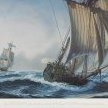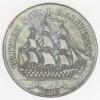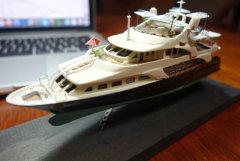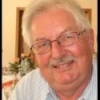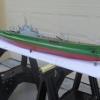MORE HANDBOOKS ARE ON THEIR WAY! We will let you know when they get here.
×
-
Posts
366 -
Joined
-
Last visited
Reputation Activity
-
 steamschooner got a reaction from popeye the sailor in Eagle of Algier 1753 by Mirabell61 - FINISHED - 1:48 - Chebec - Nils Langemann
steamschooner got a reaction from popeye the sailor in Eagle of Algier 1753 by Mirabell61 - FINISHED - 1:48 - Chebec - Nils Langemann
Nils, What a wonderful project, very nicely done.
-
 steamschooner got a reaction from lmagna in Lady Washington Brig pulled out
steamschooner got a reaction from lmagna in Lady Washington Brig pulled out
I worked in the Grays Harbor area when they were building her and would often stop by and see her coming together.
-
 steamschooner got a reaction from thibaultron in Lady Washington Brig pulled out
steamschooner got a reaction from thibaultron in Lady Washington Brig pulled out
I worked in the Grays Harbor area when they were building her and would often stop by and see her coming together.
-
 steamschooner got a reaction from John Allen in Lady Washington Brig pulled out
steamschooner got a reaction from John Allen in Lady Washington Brig pulled out
I worked in the Grays Harbor area when they were building her and would often stop by and see her coming together.
-
 steamschooner got a reaction from Canute in Lady Washington Brig pulled out
steamschooner got a reaction from Canute in Lady Washington Brig pulled out
I worked in the Grays Harbor area when they were building her and would often stop by and see her coming together.
-
 steamschooner got a reaction from mtaylor in Lady Washington Brig pulled out
steamschooner got a reaction from mtaylor in Lady Washington Brig pulled out
I worked in the Grays Harbor area when they were building her and would often stop by and see her coming together.
-
 steamschooner got a reaction from alde in Lady Washington Brig pulled out
steamschooner got a reaction from alde in Lady Washington Brig pulled out
I worked in the Grays Harbor area when they were building her and would often stop by and see her coming together.
-
 steamschooner reacted to Cathead in Arabia 1856 by Cathead - FINISHED - Scale 1:64 - sidewheel riverboat from the Missouri River, USA
steamschooner reacted to Cathead in Arabia 1856 by Cathead - FINISHED - Scale 1:64 - sidewheel riverboat from the Missouri River, USA
Roughing out the superstructure got me interested in moving forward on that aspect, so I decided to proceed on the main deck. On the stern half of the vessel, the superstructure follows the curve of the hull where it meets the guards (see photos in last post), whereas roughly forward of the engines there is no proper superstructure on the main deck, just open posts supporting the boiler deck.
In reality, the main deck was almost certainly laid before any structure was built onto it. I decided to alter this slightly and lay a thin baseline of wood where I wanted the walls to be, then plank around these. This way I could be sure to align the superstructure with the lines of the hull, which would otherwise be obscured below the planked deck. I used square strips just a hair thicker than the deck planking so they'll be almost invisible when finished. Here's a look at this near the stern:
The darker brown strips are the lines of the superstructure. I think the natural color of the wood is too bright, so I "stained" these by dunking them in a solution prepared by dissolving an old piece of steel wool in vinegar. It only takes a momentary immersion, then the wood darkens to this rich, weathered color/texture over the next 10 minutes or so. I love the look of it and will probably use this approach for most of the exposed wood where I don't use white paint. It's a bit subtle in the photo but I think you can pick it out.
I also started some deck planking. I used a long metal rule to lay out a perfectly straight line from bow to stern, then laid the first center plank along this line to ensure that I'm starting from a straight orientation. After that it's just the usual slow cut-and-fit method of deck planking, nothing exciting or innovative. If you notice that the planking seems to curve a little from the internal longitudinal bulkhead, it's the latter that has a curve in it rather than the former. That's why I used the ruler; the slight twist in the hull will be invisible as long as the planking is straight.
As for color, red was a common deck color and I like the look, but pure red looks too bright and false to me whether or not it's realistic. I like my models to have a patina of weathering that dulls the inherently false look of pure colors. So after I pre-painted long strips red, I cut each plank to length and weathered it using the dust from a black pastel stick, rubbing with my finger to get a smooth but variable coverage. Doing this for each plank ensures a subtle variance between plank that looks far more realistic than rubbing a whole finished deck at once (I paint the strips separately for the same reason). Below is an example of this planking butting up against my stained superstructure guides, followed by a closeup of a pre- and post-weathered planking strip.
You may also note that I darkened the edges of each plank to emphasize the seams slightly. Finally, here's an overview of the hull:
Doing this will occupy me for some time. While that's going on, I'll be mulling over the engine question. I have to admit, I'm considering starting over on them. It'll take another post to explain why, but the short version is that the out-of-scale aspect that I thought wouldn't be very noticeable becomes a real problem when the assembly is installed on the hull due to tight clearances. They look fine on their own, but basically don't fit where they ought. More on that when I have the heart to photograph and explain it clearly. For now, decking is a salve to my grief.
-
 steamschooner reacted to Haze Gray in USS Maine by Haze Gray - 1/72 scale - RADIO - 3D printed
steamschooner reacted to Haze Gray in USS Maine by Haze Gray - 1/72 scale - RADIO - 3D printed
Off on vacation this week but will post a few pictures of the hull of the Maine when I get back, the name plate on the stern of the boat did print out and didn’t look bad at all.
So, vacationing in japan, not too far from Yokosuka where the (pre-dreadnaught) Mikasa sits, had to stop by, pretty interesting, couple photos of that ship....
-
 steamschooner reacted to Maury S in Centerboard Schooner C. Chase 1846 by Maury S - FINISHED - Scale 1:48
steamschooner reacted to Maury S in Centerboard Schooner C. Chase 1846 by Maury S - FINISHED - Scale 1:48
While lofting (and re-lofting) I've run into a few questions. Latest ones regard the framing of the transom area. Randy Biddle (Windship Studios) has provided me with a lot of photos and drawings from the region that are proving quite helpful. Three of the many are shown below.
Back to lofting.
Maury
-
 steamschooner got a reaction from druxey in John Cudahy by steamschooner - FINISHED - 1/4" scale - Steam Tug
steamschooner got a reaction from druxey in John Cudahy by steamschooner - FINISHED - 1/4" scale - Steam Tug
Just so you all know I do work on my model from time to time. Like most I have many spring and summer things to do and do not get to spend much time in the shipyard. I have managed to cast some deck cleats( twice ) The first ones I ended up not liking, in photo on the left. The second ones are more correct with the wood block base as I have seen examples locally. For my stays and shrouds I used some telephone wire That had four coated strands and each strand has 7 small copper strands. After cleaning the coating from the wires I separated them and twisted up 3 strands for my davits and stack stays also aft mast shrouds. For my main mast shrouds I twisted up 7 strands. I used a single strand as whipping to tie off eyes. the copper wire will take L.O.S. nicely.Now on to the shroud bars/ladder.
-
 steamschooner reacted to johnp76 in Dumas Barrelback engine
steamschooner reacted to johnp76 in Dumas Barrelback engine
Nice model of a Chris Craft engine, see this link: http://www.vintagehydroplanes.com/models/1938_chris_craft_special/morley_1938chriscraft.html
-
 steamschooner got a reaction from Omega1234 in Eagle of Algier 1753 by Mirabell61 - FINISHED - 1:48 - Chebec - Nils Langemann
steamschooner got a reaction from Omega1234 in Eagle of Algier 1753 by Mirabell61 - FINISHED - 1:48 - Chebec - Nils Langemann
Nils, What a wonderful project, very nicely done.
-
 steamschooner got a reaction from Mirabell61 in Eagle of Algier 1753 by Mirabell61 - FINISHED - 1:48 - Chebec - Nils Langemann
steamschooner got a reaction from Mirabell61 in Eagle of Algier 1753 by Mirabell61 - FINISHED - 1:48 - Chebec - Nils Langemann
Nils, What a wonderful project, very nicely done.
-
 steamschooner got a reaction from mtaylor in Eagle of Algier 1753 by Mirabell61 - FINISHED - 1:48 - Chebec - Nils Langemann
steamschooner got a reaction from mtaylor in Eagle of Algier 1753 by Mirabell61 - FINISHED - 1:48 - Chebec - Nils Langemann
Nils, What a wonderful project, very nicely done.
-
 steamschooner got a reaction from Piet in Eagle of Algier 1753 by Mirabell61 - FINISHED - 1:48 - Chebec - Nils Langemann
steamschooner got a reaction from Piet in Eagle of Algier 1753 by Mirabell61 - FINISHED - 1:48 - Chebec - Nils Langemann
Nils, What a wonderful project, very nicely done.
-
 steamschooner reacted to Mirabell61 in Eagle of Algier 1753 by Mirabell61 - FINISHED - 1:48 - Chebec - Nils Langemann
steamschooner reacted to Mirabell61 in Eagle of Algier 1753 by Mirabell61 - FINISHED - 1:48 - Chebec - Nils Langemann
Dear fellow builders....
my Chebec "Eagle of Algier" has been finished totay, for the final photo session in our garden, and with a good daylight illumination.
Many thanks to all that followed the build, for looking in along the 9 months yourney and for your kind comments and compliments. Very much appreciated. Also many thanks to all the "Likes".....
The final pics-set of the "Eagle of Algier" can be seen in the scratch build gallery now...
Nils
-
 steamschooner reacted to Archie in USCG Eagle by Archie - Constructo - Scale 1:185 - first build - Modified - Steam Barque Whaler
steamschooner reacted to Archie in USCG Eagle by Archie - Constructo - Scale 1:185 - first build - Modified - Steam Barque Whaler
Over the last couple days I took my time reviewing rigging plans and got my masts and tops drilled, blocked and permanently set. This is another first for me, and it is immediately apparent that not paying attention to rigging plans down the road can get you pretty jammed up pretty fast....
To do this, I used the scale plans for measurements and gear placement, and the manual for photo orientation....
I'm very pleased with the appearance of the masts. In the bottom photo you can see I added a little bit of trywork smoke stain to the fore side of the mainmast below the first top. (The mast is upside down in the vice)
While doing this, I noticed how little I liked the kit-provided anchor chains, and so I took some old chain that I had, soaked it in Plumb Brown (a gunmetal reagent), and then replaced the bright, shiny chain from the kit, trying to keep the "working ship" motif in mind....
Once all these things were done and dried, I began the standing rigging at the bow. Another first... What I found tricky was keeping tension on all of the lines. The first line I ran was the bottommost on the foremast, and I immediately noticed that the tension on each would lessen as I went up. So, I removed it, started at the foremast top and worked my way down the mast. I ran my lines through beeswax, and used light touches of CA glue to hold lines while I lashed and took up tension.
I'm still learning how to do this, and frankly when I look at the plans and photos my hands sweat looking at the amount of rigging in front of me. But I'm taking it one line at a time, and watching it slowly come together....
Until next time....
Archie
-
 steamschooner reacted to Cathead in Arabia 1856 by Cathead - FINISHED - Scale 1:64 - sidewheel riverboat from the Missouri River, USA
steamschooner reacted to Cathead in Arabia 1856 by Cathead - FINISHED - Scale 1:64 - sidewheel riverboat from the Missouri River, USA
Thanks for the comments and likes; I certainly agree that I absolutely love the process of turning chaos into order.
I'll get back to the machinery (and an explanation of the engine inaccuracies) soon, but this weekend I decided to take a break from that arc of the project and do something quite different. Feeling the need for some motivation/inspiration, I started working out the layout of the main deck superstructure by cutting up an old water-filter cardboard box and using it to make templates for walls and decks.
We have no idea what the Arabia really looked like above-decks, as all the superstructure was washed away and there are no drawings or images to my knowledge. The painting at the beginning of this build log is an artists' rendition commissioned by the museum. that is mostly reasonable, so I'm using that as one guide so that my model approximates what people "think" she must have looked like.
However, after spending some time browsing the magnificent online collection of steamboat photography hosted by the University of Wisconsin, I've decided to also use the sidewheeler Mary McDonald as another reference. This vessel was built in St. Louis in 1866 and ran primarily on the Missouri River until 1873, long-lived for one of these boats. Although she was built ten years later, she has a very similar hull layout to Arabia and matches the painting pretty closely; everything in her design that I can would be fitting for an 1856 vessel as well. There are four good photographs and a drawing of her, covering many useful angles, making her an excellent reference. You can see all of the available images here; click on each one to get a high-quality zoomable image that really shows good detail. She's also a good match for the preliminary drawings I did of the Arabia's superstructure.
So given those resources, below are three shots of how the model looks in mock-up form.
On these boats, the deck above the main deck was confusingly called the boiler deck, although the boilers were on the main deck. The oddly named boiler deck tended to be about twice a person's height above the main deck to account for the very large machinery. Above, I've mocked up main deck walls about 13' (4m) high. The flat piece in front is a mockup of the boiler deck, though it's sitting on the main deck level, showing the outline of the main cabin, where the chimneys poke through coming up from the boilers, and the gaps near the front where the staircases will come up from below. If you look closely, you'll see a mockup person for rough scale standing in front of the port engine.
Here's a view from above so you can better see the deck layout. The boilers sit right under the main cabin outline, just behind the chimneys. They're actually drawn in pencil on the cardboard, but you can't see that in the photo (the rest is drawn in pen). As noted once before, the wheel axles would not actually cross the hull, I'm just using a single dowel here to help keep things aligned.
Here's a stern view that closely matches the angle of this photo of the Mary McDonald.
It all looks a little odd right now without the next set of decks and cabins above, but that's as far as I've gotten. It's exciting to envision the full shape and this was a fun, different exercise for the weekend.
-
 steamschooner reacted to Moxis in SS Maaninka by Moxis - FINISHED - 1/25 scale - Lake steamer
steamschooner reacted to Moxis in SS Maaninka by Moxis - FINISHED - 1/25 scale - Lake steamer
Thank you all for your kind words & likes. Very motivating to get feedback like this. Updating of the project has been a bit slow, due to nasty influenza, traveling in southern Europe and summer, which has finally arrived here. So there are a lot of other activities outside too, than sitting in the dark and dusty basement building the model.
But finally I have made all the details on the boat deck too, like the funnel with steam pipes & whistle, lifeboats including davits, and masts with their simple rigging. So we could consider the model ready. What is still missing are the functional tests and maiden voyage. And if the model is sinking or captisizes immediately, let`s keep it as a static model. But if it behaves reasonably, it may offer nice moments when sailing at it`s own surroundings.
A few words about the details on boat deck. The funnel has been made of solid balsa. Spark filter on top of it is made of admiral`s tea strainer. (please do not tell her about that). Lifeboats are made of solid balsa. First I thought to make them with POB method, but that would have taken too much work and time, and because they are covered with tarpaulin, nobody could see the inner parts of them. Davits are 4 mm round aluminium rod, bent and upper parts sanded flat. Blocks for davits are styrene.
So here we are. The model is ready and I hope that it behaves nicely on water so that I can make a nice video of it soon. Because I think you all are waiting it very eagerly.
-
 steamschooner reacted to Cathead in Arabia 1856 by Cathead - FINISHED - Scale 1:64 - sidewheel riverboat from the Missouri River, USA
steamschooner reacted to Cathead in Arabia 1856 by Cathead - FINISHED - Scale 1:64 - sidewheel riverboat from the Missouri River, USA
Moving forward on the engine assemblies:
Installing these on the cylinder timbers and adding steam drums:
Two shots of the finished & painted engines:
There are two fairly egregious inaccuracies in these engines compared to the real thing. Can you spot them? Consult the original photos here if you want to try. I'll discuss these in a future post and explain why they happened and why I'm not fixing them.
And here are three shots of the engine assemblies placed on the hull (but not attached). This gives a bit of context and scale.
Next I decide whether to start on the boilers or the wheels. I'm rather tired of working on machinery but both of those are necessary next steps before I can really move forward with deck planking and superstructure layout. I can't wait to lay the main deck!
Thanks for reading, everyone. The beginning of summer has been really hard on my modeling schedule but perhaps the depths of summer will help.
-
 steamschooner reacted to kayakerlarry in Howard W Middleton 1883 by kayakerlarry - FINISHED - scale 1:96 - coastal coal schooner
steamschooner reacted to kayakerlarry in Howard W Middleton 1883 by kayakerlarry - FINISHED - scale 1:96 - coastal coal schooner
I guess this now makes it an "official" ship...
-
 steamschooner reacted to Mirabell61 in Eagle of Algier 1753 by Mirabell61 - FINISHED - 1:48 - Chebec - Nils Langemann
steamschooner reacted to Mirabell61 in Eagle of Algier 1753 by Mirabell61 - FINISHED - 1:48 - Chebec - Nils Langemann
Update :
the sweeps (9 per side) were used for maneuvering in wind calm zones for swift attacks / escapes
Nils
the ends of the sweeps are held in place with an auxilliary support made from thin spring wire...., the ends running through the bulwark bear a zeising to prevent chafing the oar surface
-
 steamschooner reacted to Mirabell61 in Eagle of Algier 1753 by Mirabell61 - FINISHED - 1:48 - Chebec - Nils Langemann
steamschooner reacted to Mirabell61 in Eagle of Algier 1753 by Mirabell61 - FINISHED - 1:48 - Chebec - Nils Langemann
Hi Christos,
upon your special request......., here comes the crew of the "Eagle of Algier"..., enjoy...
The ship is now nearly complete, there are also some banners, and flag attached.
On the stb. side I will be fitting 9 sweeps through the oarports
Nils
if my Google translator (into Arabien letters) worked correct, that should read "Eagle of Algier"
the old flag of Algier Port
the "blue pirate" is always a bit of a hot head
the helmsman still requires a compass and perhaps a small binacle cabinet
cleaning with seawater
-
 steamschooner reacted to Mahuna in Kathryn by Mahuna - FINISHED - 1:32 - Skipjack Based on HAER Drawings
steamschooner reacted to Mahuna in Kathryn by Mahuna - FINISHED - 1:32 - Skipjack Based on HAER Drawings
Part 63 – Dredge Rollers
Kathryn has dredge rollers that are configured like the typical skipjack’s rollers. The supports for the rollers are fairly complex, and I decided to model them as close as possible to the actual supports.
The forward support is constructed so that it wraps around the aft part of the forward railings, and the top of the support is slightly lower than the top of the railing. The axis of the roller fits into a notch in a plate on top of the support, and there is an extended piece that prevents the roller from slipping out of its support.
The aft roller encases the entire railing configuration, and the axis of the roller fits into the front of the support. At the top of the aft support there is a slanted piece that supports the vertical roller.
Each of the supports has an inboard triangular brace.
On the model, the main part, or body, of each support was made the same way – as a single piece folded over to encase the rail. First, an appropriate sized piece of brass strip (1/8” x .025”) was scored where the folds would occur.
These scores were used to register a small triangular file that was used to open up the scores.
After annealing the strip it was clamped in the vise and bent, then hammered, to make a 90 degree bend.
The strip was then clamped to a 5/32” x 1/8” square tube (the width of the rail is 5/32”) and bent and hammered. This corner wound up being slightly rounded – probably unavoidable.
The workpiece was then held in a jig made of Corian, and the base was soldered onto the body.
The following photo shows the body of the forward support test-fitted to the railing.
A small piece of 1/8” x .025” strip was soldered to the top of the forward support body in order to form the vertical piece that the roller axis rests in.
Still clamped in the jig, the vertical piece was shaped to fit the contours of the support body, using a rotary tool and files, and the notch in the vertical piece was made using a small round escapement file.
The extension for securing the roller was then soldered in place.
This completed the forward supports for the dredge rollers.
As can be seen in the above photo, the constant test fitting of the support has resulted in some marring and dirtying of the painted surface. This will need to be cleaned up before final installation of the supports.
The body of the aft support was made the same way, with the addition of a front plate that was soldered to the body after bending was completed.
The triangular inboard support was added to all four of the supports, using the following setup for soldering. The heavy block on top of the ‘third hand’ is to ensure that the piece makes full contact with both the bottom and the vertical surfaces of the support.
The angled piece on the aft roller support, for supporting the vertical roller, was made from a piece of brass angle, and was shaped to conform to the support body. The forward and aft supports can be seen in the following photos.
The rollers shown in the HAER drawings, and in a photo taken at about the same time as the HAER survey, shows sleeves at both the fore and aft ends of the rollers.
Although these sleeves could have been turned on the lathe, it was much simpler to make them out of tubes that would fit over the roller bodies and each other.
The roller bodies (1/8” brass rod) were drilled with a center drill and then drilled to take the axis pieces (3/64” brass rod).
The rollers were test-fitted to the supports.
The sleeves were then soldered to the rollers.
The dredge rollers are now ready for blackening, and for the installation of the aft vertical rollers.
I love the look of the clean brass, but in keeping with my plan to make the model look as much as possible like the real Kathryn, the brass will be (dis)colored.
I feel like I should apologize for this long post and the many photos, but I wanted to show the process as complete as possible. The next post will complete the installation of the dredge rollers.




